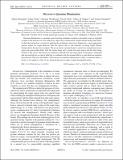| dc.contributor.author | Barzanjeh, Shabir | |
| dc.contributor.author | Guha, Saikat | |
| dc.contributor.author | Weedbrook, Christian | |
| dc.contributor.author | Vitali, David | |
| dc.contributor.author | Shapiro, Jeffrey H. | |
| dc.contributor.author | Pirandola, Stefano | |
| dc.date.accessioned | 2015-03-03T19:20:39Z | |
| dc.date.available | 2015-03-03T19:20:39Z | |
| dc.date.issued | 2015-02 | |
| dc.date.submitted | 2015-01 | |
| dc.identifier.issn | 0031-9007 | |
| dc.identifier.issn | 1079-7114 | |
| dc.identifier.uri | http://hdl.handle.net/1721.1/95759 | |
| dc.description.abstract | Quantum illumination is a quantum-optical sensing technique in which an entangled source is exploited to improve the detection of a low-reflectivity object that is immersed in a bright thermal background. Here, we describe and analyze a system for applying this technique at microwave frequencies, a more appropriate spectral region for target detection than the optical, due to the naturally occurring bright thermal background in the microwave regime. We use an electro-optomechanical converter to entangle microwave signal and optical idler fields, with the former being sent to probe the target region and the latter being retained at the source. The microwave radiation collected from the target region is then phase conjugated and upconverted into an optical field that is combined with the retained idler in a joint-detection quantum measurement. The error probability of this microwave quantum-illumination system, or quantum radar, is shown to be superior to that of any classical microwave radar of equal transmitted energy. | en_US |
| dc.description.sponsorship | United States. Air Force Office of Scientific Research | en_US |
| dc.description.sponsorship | United States. Office of Naval Research | en_US |
| dc.publisher | American Physical Society | en_US |
| dc.relation.isversionof | http://dx.doi.org/10.1103/PhysRevLett.114.080503 | en_US |
| dc.rights | Article is made available in accordance with the publisher's policy and may be subject to US copyright law. Please refer to the publisher's site for terms of use. | en_US |
| dc.source | American Physical Society | en_US |
| dc.title | Microwave Quantum Illumination | en_US |
| dc.type | Article | en_US |
| dc.identifier.citation | Barzanjeh, Shabir, Saikat Guha, Christian Weedbrook, David Vitali, Jeffrey H. Shapiro, and Stefano Pirandola. “Microwave Quantum Illumination.” Physical Review Letters 114, no. 8 (February 2015). © 2015 American Physical Society | en_US |
| dc.contributor.department | Massachusetts Institute of Technology. Department of Electrical Engineering and Computer Science | en_US |
| dc.contributor.department | Massachusetts Institute of Technology. Research Laboratory of Electronics | en_US |
| dc.contributor.mitauthor | Shapiro, Jeffrey H. | en_US |
| dc.relation.journal | Physical Review Letters | en_US |
| dc.eprint.version | Final published version | en_US |
| dc.type.uri | http://purl.org/eprint/type/JournalArticle | en_US |
| eprint.status | http://purl.org/eprint/status/PeerReviewed | en_US |
| dc.date.updated | 2015-02-27T23:00:04Z | |
| dc.language.rfc3066 | en | |
| dc.rights.holder | American Physical Society | |
| dspace.orderedauthors | Barzanjeh, Shabir; Guha, Saikat; Weedbrook, Christian; Vitali, David; Shapiro, Jeffrey H.; Pirandola, Stefano | en_US |
| dc.identifier.orcid | https://orcid.org/0000-0002-6094-5861 | |
| mit.license | PUBLISHER_POLICY | en_US |
| mit.metadata.status | Complete | |
